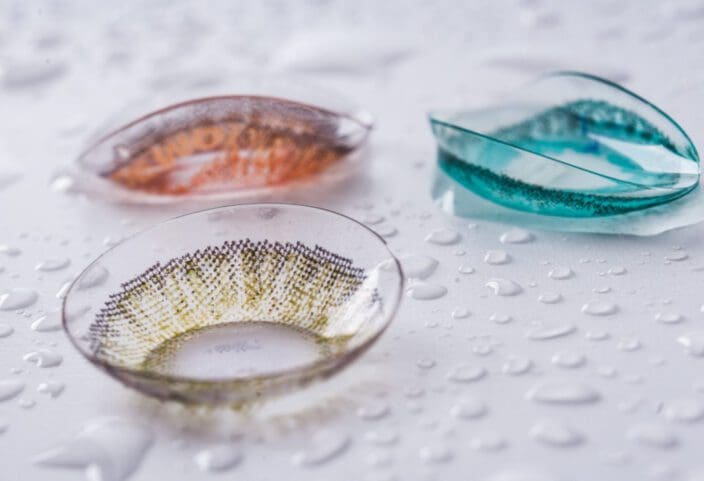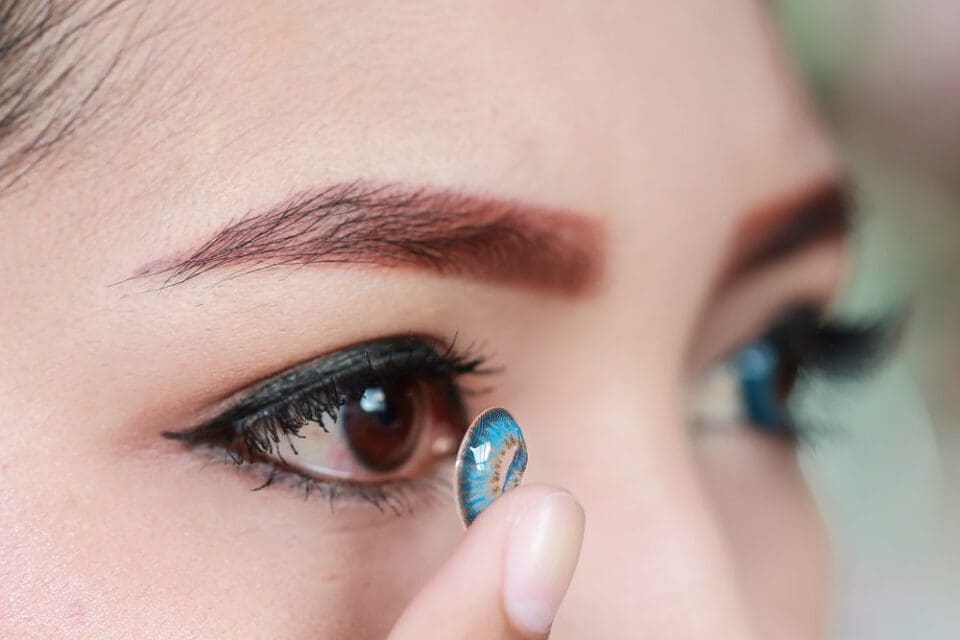What to Look for in Non-Prescription Colored Contacts
Home / Understanding Contacts /
Last Updated:
If you want to get into character for a holiday or event, or just change your eye color for fun, color contact lenses that are non-prescription could be the way to go. To ensure eye health, you have to be cautious and make the right choices about non-prescription colored contacts.
Table of Contents
If you do not need vision correction, it is important to not use prescription colored contacts. This could distort your vision.
Learn about the available materials and options so you pick the right pair for you. Eye irritation is possible, but you can be prepared by knowing the risks.
Assess the quality of the provider and the materials. This will ensure you pick a pair that will be comfortable to wear.
How Do Non-Prescription Colored Contacts Differ From Prescription Ones?

Non-prescription colored contacts do not offer any level of vision correction. They are purely for fun or vanity. If you have a refractive error or other issue that affects your vision, you will need prescription contact lenses to provide greater visual acuity.
There are prescription contact lenses that come in colors if you want this feature and vision correction. Whether you choose prescription or non-prescription options, you still need a prescription from a doctor in the U.S. to get the lenses. Contact lenses are considered medical devices.
You deserve clear vision. We can help.
With 135+ locations and over 2.5 million procedures performed, our board-certified eye surgeons deliver results you can trust.
Your journey to better vision starts here.
For both types of lenses, you need to have a proper fitting. If your lenses are not ideal for your eye shape, you can experience discomfort and are at a higher risk for more serious issues, such as corneal infection or scratches.
What Is a Non-Prescription Colored Contact Lens?
Non-prescription colored contacts are usually soft contacts. This type of lens is often made from a type of plastic that absorbs water, so your contacts remain supple and soft. They retain water and allow for oxygen to get to your eyes for comfort.
When you are ready to buy a pair, ask your eye doctor for recommendations. It is imperative that you only obtain your non-prescription colored contacts from a reputable source.
If you have a prescription, you can purchase them from various retailers like these:
- Lens.com
- Warby Parker
- CVS Optical
- Target Optical
- Street vendors
- Boutiques
- Novelty stores
- Convenience stores
- Beauty supply stores or salons
- Flea markets
- Halloween stores
- Websites that do not require you to have a prescription from a doctor
Avoid getting them from the following places:
Why Do People Use Non-Prescription Contacts?
These contacts allow you to change your eye color. Some people may want a specific eye color for an event, such as Halloween or even their wedding or a photoshoot.
You can find these lenses in a wide array of colors, from conventional eye colors, such as various hues of brown, blue, and green, to novelty colors, like purple, orange, and red.
What Are the Risks of Wearing Non-Prescription Colored Contacts?
A number of issues can occur if your lenses fit poorly, such as:
- Corneal scratches. A scratch on your cornea can result if your contacts fit poorly and move around your eye when you are wearing them. This can cause moderate to severe pain. Redness, light sensitivity, blurriness, and watery eyes are also possible.
- Conjunctivitis (pink eye). The lining that covers the white part of your eye can become swollen and inflamed, resulting in conjunctivitis. When this condition is present, your eye appears pink. It can feel irritated, cause watery eyes, feel itchy, and cause your eyelids to swell.
- Corneal infection. An infection in your cornea can result in an ulcer, which is a type of open sore. This can lead to blurriness, itching, pain, a white patch developing on your cornea, redness, discharge, light sensitivity, and watery eyes. If treatment is not initiated quickly, you are at risk for scarring on your cornea.
- Decreased vision. If your contacts fit poorly, they may interfere with your vision. This is also possible if they are low in quality and the colored part of the contact obstructs your pupils.

Poor fitting and low-quality materials increase your risk of infection. The most severe consequence of this issue is blindness.
It is important that you are aware of the materials used in the contacts, including the dyes and other ingredients used to color the contacts.
You deserve clear vision. We can help.
With 135+ locations and over 2.5 million procedures performed, our board-certified eye surgeons deliver results you can trust.
Your journey to better vision starts here.
How to Choose a Good Pair of Non-Prescription Colored Contacts
The easiest way to get a quality pair is to ask your doctor for recommendations. Most of the big contact lens brands offer at least one type of non-prescription colored contact lens.
You can choose to get them from a website, like those mentioned above, or physical store. Just ensure that any retailer requires you to present a prescription. You can read some reviews online to see which brands have the features and colors you want.
These are popular brands of colored contacts:
- Alcon’s FreshLooks: These cost about $52 for a box of 6 lenses.
- Alcon’s FreshLooks ColorBlends: These cost about $40 for a box of 6 lenses.
- CooperVision’s Expressions Colors: These cost about $75 for a box of 6 lenses.
- Alcon’s Air Optix Colors: These cost about $45 for a box of 6 lenses.
Once you have your non-prescription colored contacts, read the usage and care instructions. It is important that you follow these carefully to protect your eyes and keep your contacts in good condition.
Changing your eye color can be fun for costume parties and similar events. Just be sure that you choose a quality pair so you do not cause harm to your eyes.
Colored Contacts FAQs
Are colored contacts safe?
Yes, colored contacts are safe if they are properly fitted and purchased from a legitimate retailer. You must see an optometrist to be fitted for contact lenses, even if you are only using them for aesthetic purposes.
Where should I buy colored contacts?
Buy colored contacts from an authorized retailer that requires a prescription. If a retailer does not require a prescription, it’s a sign that they are not a legitimate operation.
How long can you wear colored contacts?
You can wear colored contacts as long as specified by the specific brand’s usage instructions. Most colored contacts are disposable lenses that should only be worn for up to 30 days.
What are the risks of colored contacts?
Colored contacts carry the same risks as standard contact lenses. Use of colored contacts increases the risk of corneal scratches, infection, allergic reactions, and injuries to the eye. When purchased from an authorized retailer and cared for properly, the risk potential is low.
How do I keep my eyes healthy when wearing colored contacts?
Follow the specific use instructions on the contacts box, and never wear them for longer than specified. Clean them with sterile saline solution, and wash your hands before putting the contacts in your eyes.
You deserve clear vision. We can help.
With 135+ locations and over 2.5 million procedures performed, our board-certified eye surgeons deliver results you can trust.
Your journey to better vision starts here.
References
- Colored and Decorative Contact Lenses: A Prescription Is a Must. (July 2017). Food and Drug Administration.
- Types of Contact Lenses. (January 2018). US Food and Drug Administration.
- Pretty Scary: Colored Contact Lenses Can Damage Your Eyes. Healthline.
- What Is a Corneal Abrasion? (April 2019). American Academy of Ophthalmology.
- Corneal Ulcers and Infections. MedlinePlus.
- Contact Lens Risks. (September 2018). US Food and Drug Administration.
This content is for informational purposes only. It may have been reviewed by a licensed physician, but is not intended to serve as a substitute for professional medical advice. Always consult your healthcare provider with any health concerns. For more, read our Privacy Policy and Editorial Policy.
